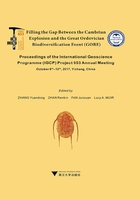
Ecological Gradient of a Brachiopod Fauna from South China after the End-Ordovician Mass Extinction and Its Significance
1 State Key Laboratory of Palaeobiology and Stratigraphy, Nanjing Institute of Geology and Palaeontology, Chinese Academy of Sciences, Nanjing 210008, China; bhuang@nigpas.ac.cn, jyrong@nigpas.ac.cn, rbzhan@nigpas.ac.cn;
2 Palaeoecosystems Group, Department of Earth Sciences, Durham University, Durham DH1 3LE, UK;david.harper@durham.ac.uk.
Classification of extinction events and their severity is generally based on taxonomic counts. The ecological impacts of such events have been categorized and prioritized but rarely tested with empirical data. In a recent study, the ecological severity of the end-Ordovician event was considered to be even less significant than that of the serpukhovian, and was ranked only sixth of the 11 largest Phanerozoic crises since the beginning of the Ordovician Period. South China offers a key opportunity to examine the ecological changes through the end-Ordovician event in detail.The Cathaysiorthis fauna is a shelly fauna dominated by brachiopods from the uppermost Ordovician to lowermost Silurian of southeastern China, succeeding the cool-water Hirnantia Fauna.The fauna is abundant and has a relatively high diversity; these data were reported with the detailed systematic descriptions of the fauna. The spatial and temporal ranges of more than 6500 identified specimens from 10 collections derived from 6 localities were investigated by network and cluster analyses, nonmetric multidimensional scaling and a species abundance model. The ecological circumstances of the survival brachiopod fauna after the end-Ordovician mass extinction were evaluated. Other, older brachiopod faunas, the Altaethyrella fauna and Foliomena fauna, which characterize the late Katian within the same area, were compared in terms of diversity, population structure, benthic assemblage zones and relative abundance together with their major components to help further elucidate the ecological ‘turnover' through the end-Ordovician extinction event in South China. The depth zonations and structures of the brachiopod assemblages along an onshore-offshore gradient in the late Katian were similar to those in the latest Ordovician-earliest Silurian (post-extinction fauna). The widths of the ecological ranges were similar between before and immediately after the crisis, which may suggest a limited ecological effect of the event. Within this ecological framework, deeper-water faunas were partly replaced by new taxa; siliciclastic substrates continued to be dominated by the more ‘Ordovician' orthids and strophomenids and shallow-water carbonate environments hosted atrypids, athyridids and pentamerids, with the more typical Ordovician brachiopod fauna continuing to dominate until the late Rhuddanian. The end-Ordovician extinctions tested the resilience of the brachiopod fauna without damage to its overall ecological structure; that commenced later at the end of the Rhuddanian.